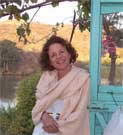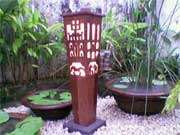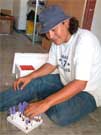This is the old Ternyata site, maintained for archival purposes. You can see the new site at http://www.ternyata.org
By ELIZABETH PISANI
980 words
22 April 1996
Asia Times
(c) 1996 Chamber World Network International Ltd
Traipsing through the Cambodian countryside is not for the faint-hearted - in every shadow lurks a ghost of the country's barbaric past. Wander into a collapsed schoolhouse a couple of kilometers down a dirt track from a favorite Khmer picnic spot at Tonle Bati, for instance, and you will find a mountain of skulls piled up on what might once have been the school stage. The remains of maybe 3,000 people are in a shapeless heap in the blinding sunshine; nearby, stray parts of men and women are scattered around the fields they once farmed.
Village women graze their cattle around the decay of their families. They show not a flicker of emotion at this half-hidden reminder of the dreadful years of Khmer Rouge rule - a reminder that is repeated over and over in corners of Cambodia. Some have taken historical catharsis a step further. Not content simply to ignore unburied human remains, a number of people were recently arrested for trading skulls across the border into Thailand "for use in fertilizer and religious ceremonies", according to local press reports.
Usually unnoticed details assume unexpected importance in Cambodia's landscape of bitter memories. Cowpats, for instance are a good sign. If cows have passed, the chances are they've already detonated any stray landmines, the volatile calling-cards of the war that nags on at the country's people.
Most of these thigh bones probably belonged to peasants, worn to death by the hunger and exhaustion that came with the Khmer Rouge's catastrophic experiment in agricultural millenarianism. Many of the better-off were able to escape to the West - they are only now returning to live among the ghosts of their past lives.
Among the cool pines of Kirirom national park, an aging gentleman contemplates the shell of what was once his holiday villa - his tranquil escape from the heat of his life as a general. "They had the kindness to leave me the foundations," he said with a sardonic shrug. His companion, now a senior official in the Mekong River Commission, reminisces in impeccable French about the good old days.
"Sitting up on our verandah on the hill over there listening to the wind in the trees, with a little coffee, the newspaper. Things were civilized then."
Little of his house remains - the pain of its loss is perhaps dulled by the time he and his wife now spend in five-star hotels in Thailand and Paris while on government business.
The villas of gracious times past are hollow shells, stripped bare, their former owners say, of even the electrical wire embedded in the walls by the Vietnamese troops who stormed into the country in 1979 to dislodge the Khmer Rouge. "They took everything they could possibly sell, even for a few cents," the general sighed.
Rank was no protection. King Sihanouk's villa, commanding a splendid view from the park's highest point, was as desolate as the rest until a year ago, when a British oil company sponsored the reconstruction of the chimney and a wooden deck as a monument to the past. Now it has become a favorite recreational spot for the government troops that are stationed in the park in the continuing fight against the Khmer Rouge. In the middle of the day, six soldiers swagger out of the ruins of the royal villa, ostentatiously buckling their belts.
They are followed by a couple of haggard women hitching up their sarongs. All around lie the monuments of the new open market - crumpled cigarette packets, empty Johnnie Walker bottles.
The King's seaside villa at Kep has fared no better, a middle link in a chain of wrecked houses which stand shoulder to shoulder along the coast, windows and doors gaping hungrily.
Set back off the beach, a once smart girls' school has been reduced to a shell, its innards plucked out by impoverished soldiers and time.
The litany of decay may soon be brought to a halt by development which began to creep through the country since peace - relative peace - was restored in 1992. In the nearby provincial capital of Kampot, rumors abound that all the villas at Kep have been bought by a wealthy Chinese businessman who wants to conjure the elegant resort back from the dead. But such rumors are as hard to pin down as the ghosts that haunt the length of the coast.
Flit down as far as Kompong Som - Sihanoukville to the pedantic - and you will find among the plans for gleaming new luxury resorts a hotel macabre enough to put the set designers of a Hitchcock film to shame. Perched on a hill above the sea, the International Hotel, graced with a logo remarkably similar to that of the Hilton International chain, is just plain spooky. A mirrored ball hangs heavy above the warped wood of the dance floor.
Astonishingly, it has escaped the gunfire that has left the inner walls of the hotel covered in pockmarks. Upstairs, the stuffing leaking from the mattress of an upended replica Louis XIV bed, is wafted down the corridors by a gentle sea breeze coming through the hollow window-frames.
Some of the rooms have numbers chalked on plywood doors and moldy mattresses on the floor. Local entrepreneurs-in-training, running practical experiments in market economics, are hiring them out on a short-time basis to anyone looking for a private corner.
A paunchy businessman emerges from one of the rooms, pushing a slack-eyed girl in front of him. She is young - perhaps young enough to see her country exorcise its ghosts, to see the energy and resources it once directed at destruction turned, instead, to building a solid future.
Elizabeth Pisani is an Asia Times correspondent.
Copyright 1996 Asia Times.
(c) 1996 Chamber World Network International Ltd.
|




